Equipped for ‘mad' growth
January 29, 2014
As the self-proclaimed largest family-owned winery in Western Australia (WA), Howard Park Winery is rapidly expanding its bottling capabilities and brands. As part of these improvements, it has installed a still-wine bottling line at its Margaret River facility in Cowaramup, WA. The new line enabled the vintner to incorporate more sustainable packaging materials into its primary and tertiary packaging. It also resulted in the addition of three new wine brands-Allegory, Sideways and Kite Runner-to the winery's already extensive portfolio, which includes MadFish, Howard Park, Marchand & Burch, Strait Jacket, Gold Turtle, MadBay, Two Fins and Fire Tree.
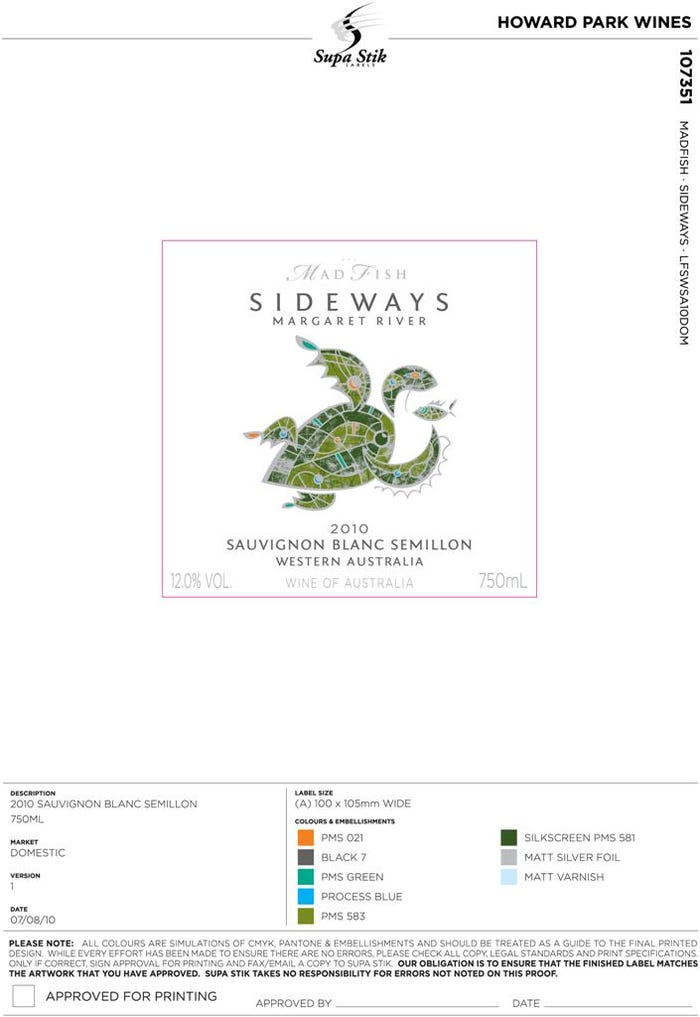
proof sheet for a MadFish Sideways label
The Sideways brand's packaging incorporates the high-end labeling that also beautifully decorates Howard Park's MadFish bottles. These are artfully printed by award-winning Australian label converter Supa Stik Labels and Labelling Systems Pty Ltd. on its Codimag Viva 340 waterless-offset combination press. This press is engineered to produce high-end labels that are especially suited for the wine, health and beauty, and household products industry.
The Codimag Viva 340 press at Supa Stik is specifically set up for the wine industry, as the company specializes in labeling for the pharmaceutical and wine industries, which Supa Stik CEO Peter Holywell says require a high level of technical capability and tradesman skill. Howard Park MadFish labels benefit from the control offered from a multitude of inline finishing processes. According to Codimag, the Viva 340 is one of the few intermittent presses on the market with all the major printing or finishing processes inline in intermittent mode: waterless offset, letterpress, screen-printing, hot foil stamping, embossing, flexo varnishing, wet laminating and die-cutting.
Describing the finishing and imaging control needed for Howard Park Winery's MadFish labels, which are six-color, embossed and silk screened, Holywell says: "It's a label that requires quite a lot of control. They are quite complex, and they're printed on a metallic stock. When you're dealing with metallic stocks, slight variations in the white layer make very big differences to the finished result."
Holywell notes that technology alone doesn't determine package and label printing quality, and he boasts of the skill of two Supa Stik pressmen, Gary Sears and Paul Shearon, who worked most closely with these labels. "We like to think of ourselves as the destination company for the designers, and part of ensuring that is going an extra mile with the designers to get the finished result," Holywell explains. "We're very fortunate in WA: It's got quite of a vibrant design industry around the wine industry, so we have access to a lot of outstanding design work. Our guys get quite used to working with designers press-side, and they are familiar with going the extra mile to get the results designers want."
He explains that quality is critical in these industries and while virtual proofing is taking hold throughout much of the graphic arts and printing markets, it is not the preferred method of proofing for his clients, who demand old-fashioned on-site proofing.
Quality, Holywell remarks, doesn't begin and end at the press though. "We put a lot of time into prepress," he remarks. "Particularly with much of the complex wine work, very minor data can make significant differences to the end result."
The company uses ArtPro Odyssey software to prepare its label and package printing files. "We've used that for a few years now," Holywell states. "We're quite familiar with that program now and how their parameters are set up, and that works quite well for us." (This software and the ArtPro brand are now part of EskoArtwork.)
This close attention to detail pays for Supa Stik in accolades from Howard Park Winery. "We love Supa Stik," Natalie Burch, operations manager for Howard Park remarks. "Dealing with them is brilliant. We were with another label company, who I won't mention, and were having a few problems. So we shopped around, and Supa Stik came up as the best option. We've been with them and since we haven't looked back."
Bottling dynasty
Burch also sings the accolades of Mick Franks of systems integrator Wine Industry Services and Howard Park's own bottling manager Allan Stanbury, who executed the installation and design of a still-wine bottling line that's used for MadFish and MadFish Sideways.
"The guy who's running the bottling line-Allan Stanbury-is a one of the local gurus," remarks Burch. "Everyone comes to him for advice, whether it's case packing, bottling or whatever. Al's amazing. He's also part of a bottling family dynasty."
"My son, Martin, has seven years as production manager at Capel," Stanbury boasts, "and my daughter, Vonny, was a bottling technician at Capel and now works at Howard Park Winery." Stanbury also was working at Capel Vale Bottlers when Howard Park approached him about setting up Margaret River still-wine bottling line.
"We pinched him from where we were bottling before," Burch admits. "I think he was looking at moving on, and we've been procrastinating about putting in our own line for a long time, just because we weren't sure if we had the volume and that sort of thing. We thought we would probably end up bottling for eight months and the other four months we'd be twiddling our thumbs. Well, it hasn't actually turned out that way." Instead, Burch says, the winery is struggling to keep up with demand.
Still-wines run clean
The bottling process begins with Lean+Green bottles, supplied by Owens-Illinois Inc. (O-I), being forklifted onto a scissor lift. Howard Park invested in a scissor lift in consideration of employee safety.
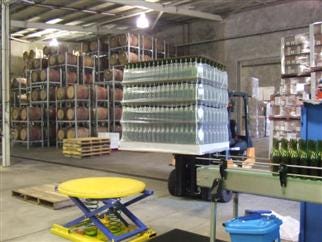
pallet of empty glass being transported to the filler
The scissor lift raises the empty bottles as the line worker manually removes them from the pallet and loads the glass onto a conveyor, which was manufactured by Wine Industry Services.
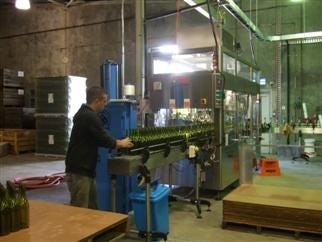
loading glass onto the line
The empty bottles are conveyed to a Fimer 16/16/1 monobloc filler. "When we say 16/16/1, that's 16 valves for rinsing, 16 valves for the filling, and a single station for the either screw capping or corking, and the monobloc can achieve say 2,800 per hour," Wine Industry Services director John Camilleri explains.
Bottles enter the rinser through a starwheel, where they are inverted over a spray nozzle that injects clean, recirculated water into the glass. "The Fimer has a recirculation tank and pump for rinse water," Stanbury explains. "Water passes through 0.5µm and 0.2µm membranes and a UV system prior to rinsing." The water is blown off by aerators supplied with sterile air from a laminar air flow unit.
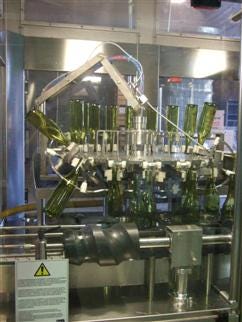
bottle rinsing closeup
To reduce dissolved oxygen pick up, the filler's nitrogen sparging station displaces the air in the bottles before they move to a second starwheel, where they are placed on individual mechanical lift plates. Camilleri says that the Fimer filling method prevents excessive exposure of the wine to oxygen.
"A common problem with some of the cheaper model low-vacuum fillers is that when there's no bottle in position, the vent tube draws air out of the bottle and into the wine space where the wine is stored for filling," he explains.
When a bottle is in position and is going up [on a cam lift] on a Fimer machine, it opens the vacuum valve for the first time. The bottle then moves forward only a couple degrees and the filling valve is physically opened allowing the wine to enter the bottle. The opposite happens as the bottle is coming out of the machine. The filling valve closes first, and then the vacuum valve closes seconds after. "This two-stage valving is very favorable with high-quality wine makers who are concerned about oxygen pickup," Camilleri says.
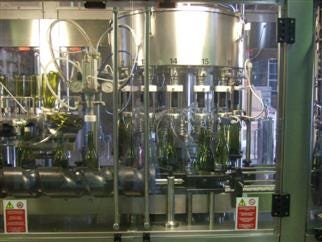
bottle filling
Screw caps, supplied by Amcor, are moved by an automated cap elevator system by Ctech srl Regione San Vito 90 from a 2,500 capacity hopper to the filler, where a spinning head places the metal caps onto the bottles. As filled and capped bottles exit the filler, they are inspected then moved to a three-lane accumulation area.
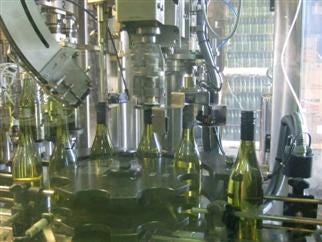
capping
"A key issue with quality wine filling is to keep the filling machine running and not stop-start, because a lot of customers are concerned about the oxygen pick-up in the wine," Camilleri remarks. "So we redesigned the line with bottle accumulation that allows an operator to change a label roll while the filler continues to run."
The bottles are moved back to a single lane before passing the Cavagnino and Gatti Co. CG-TL4/2-3XPSP labeler. The three-head system applies front and back labels, and can apply medallions. A Julian date and bottling time are printed on the back label of each bottle with a Hitachi inkjet printer to allow for traceability.
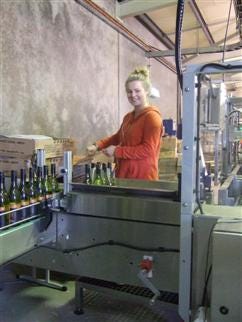
case packing
Case packing is done on a Recopak OPPS overpacker. "This machine requires one person to drop in a divider and place an open carton over the top of the selected, collated pattern," Stanbury explains. "Filled cases then transported to a Nordson [Pro] Blue glue unit for sealing."
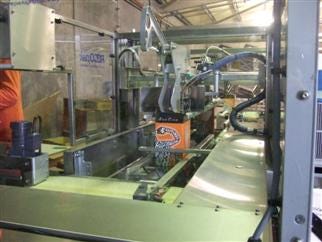
wraparound case packer
To accommodate the marking requirements of the different geographical markets Howard Park serves, a Label-Aire Inc. print-and-apply labeler prints a bar code and other required data on a p-s label, then applies it to the front and side of each case.
Not all smooth sailing at Margaret River
The Margaret River still-wine bottling installation wasn't without its challenges. There was a strong internal drive at Howard Park to incorporate sustainable packaging materials in the new bottling and case packing process. The company accomplished this by moving to the Lean+Green bottles and new printed cases, supplied by Visy, that are made from recycled fiber.
"The moment we found out that the bottle was possible, we decided we were going to go down that path," Burch recalls. "Then, we found a bit of variation within each pallet (of bottles.)"
This required Howard Park to make changes to the starwheels of its filler and prompted the move to the new cases. Burch remarks that the changes were accomplished using standard change parts and by working closely with its supplier partners, and they were worth the effort.
Lean+Green is aimed at vintners looking for lighter weight packaging with a premium image. O-I says the bottles are aesthetically similar to traditional wine bottles, but provide a lower carbon footprint realized from both the manufacturing process and lower energy usage during transport. According to the packaging supplier, sustainable wins by reducing 1 million bottles from 15.5 oz to 13 oz include: 89 metric tonnes (more than 98 U.S. tons) less carbon dioxide created, thus enabling 4,100 trees to be available to absorb other greenhouse gases.
It enabled Howard Park to provide a more sustainable option without going to alternative packaging, which the mere mention of elicits polite but audible groans from Burch. "We will never do any of them," she remarks. "As a company that's got a lot of high-end and medium-level wines and as a family, we have made a decision not to go down that road because it just looks disgusting from our perspective.
"There's something sexy about opening a bottle of wine," she adds. "There's not something as sexy about opening a bag of wine."
Amcor, +61-8-8433-2510.
www.amcor.com
Cavagnino and Gatti Co., +39-141-823231.
www.cavagninoegatti.com
Codimag, +33-1-6086-4075.
www.codimag.fr
Ctech srl Regione San Vito 90, +39-141-822625.
www.ctech-machines.com
EskoArtwork, 937-454-1721.
www.esko.com
Fimer, +39-1-4182-3404.
www.fimer.it
Hitachi America Ltd.,
704-494-3008, x21.
www.hitachi-america.us
Label-Aire Inc., 714-449-5155.
www.label-aire.com
Nordson Corp., 770-497-3700.
www.nordson.com
Owens-Illinois Inc., 567-336-5000.
www.o-i.com
Recopak Machinery Pty. Ltd., +61-3-5781-0512.
www.recopak.com.au
Supa Stik Labels and Labelling Systems Pty Ltd., +61-8-9441-5000.
www.supastik.com.au
Visy, +61-13-8479.
www.visy.com.au
Wine Industry Services,
+61-8-8251-5055.
www.wineindustryservices.com
About the Author(s)
You May Also Like


